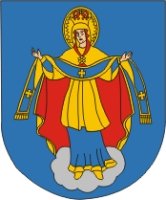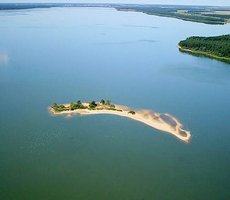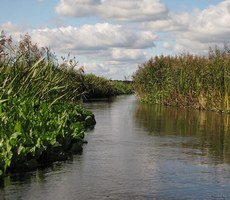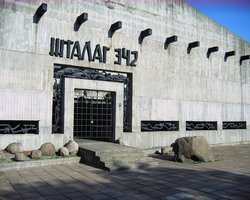Министерство образования Республики Беларусь
Управление по образованию Молодечненского райисполкома
Государственное учреждение образования
"Гимназия №6 г. Молодечно имени С.Т.Демешко"

The district was formed January 15, 1940. Located in the northwest of Minsk region our district borders on Volozhin, Vileika, Minsk and Smorgon districts. About 75% of the district is located on Minsk upland. The relief is hilly. The area is 1.39 thousand sq. km. The rivers Usha, Vilia, Berezina flow through the region. The part of Vileika-Minsk water system is situated here.The district specializes in the production of milk, meat, grains. The cultivation of potatoes, beet and flax is also developed here. There are 16 agricultural organizations and 50 private farms on the territory of the district. 52 enterprises of the major industrial group work in the district.
In 2011 more than 2550 economic entities and more than 4900 individual entrepreneurs worked in the district.
The territory of the district is divided into the town of Molodechno, urban settlement Radoshkovichi and 14 village councils (268 settlements all in all).
The largest settlements in the district are urban settlement Radoshkovichi (population – 589 people), settlement Chist (population – 5345 people), village KrasnoeThe population of the district consists of Belarusians-92.3%, Russians-5.2%, Poles-0.6% and other nationalities-1.9%.

Coat of arms of Molodechno
The coat of arms of the town was adopted December 21, 1999.
The coat of arms of Molodechno: "The Virgin is in gold crown, blue-and-gold clothing and gold mantle with red lining. The Virgin is standing on a silver cloud holding a blue coverlet with three Chevalier Crosses”.
The registration number of the coat of arms in Belarusian heraldic register is 39. It was approved by the Town Council of Deputies on December 21, 1999.
There are 50 companies of the main industrial group in the district (9 state-owned enterprises and 41 private companies). More than 16300 work in the industrial sector. The structure of industry branches is diverse. It includes food industry, metal working, production of construction materials, furniture production, light industry, perfumery, ceramics industry, etc.
The following enterprises have the largest shares in district production volume: LLC "Triple-Veles” (30.1%), JSC ”Molodechno Milk Processing Plant” (11.2%), "Molodechno Metalware Plant Republican Unitary Enterprise”(8.8%), JSC "Zabudova” (6.5%), "Molodechnomebel” Ltd.(4.1%).
14929 people work in the industry.
District agriculture includes 15 agricultural organizations and services. 62 farms are registered in the area. The number of workers makes up 3300. Agricultural organizations cultivate 60873 ha of land including 40248 ha of tillage. Agricultural land and tillage have a qualitative assessment of 32.1 and 34.3 points accordingly. District agricultural organizations specialize in cattle breeding, cultivation of crops, sugar beet, flax, rape, potatoes. There are 93 stock-raising farms in agricultural organizations including 55 dairy and 10 pig-breeding farms. The district is known for its battery farm, pork production complex and bakery.
There are 65 registered farms in Molodechno district. The average size of farm land makes up 40.4 ha while the total area of cultivated land is 2640 ha. including 1582 ha of tillage. In 2012 farmers stated that 120 ha of land was provided for crop rotation.
Farms specialize in crop production, cattle breeding, gardening, vegetable-growing, fish-breeding. There are registered farms involved in cultivation of medicinal plants, snail and crayfish breeding.
Molodechno district exports metal production (round pipes, tubes of rectangular cross-section, medical instrument and furniture, machinery, metal profiles, fridge componentry, road repair equipment, retarders, electric loaders, friction products), furniture, electrical equipment, cheese, butter, confectionary, powdered milk, sausages, semi-finished goods, alcoholic beverages, mineral water, perfumery, building materials, extinguishers, etc.
The district imports frozen pork, ferrous and non-ferrous metals, non-ferrous metal powders, lacquers and finishing agents for furniture industry, electronic components, equipment, goods made on commission.
Molodechno district is a land of uniquely magnificent nooks. Getting to the area of this part of Belarus is as if you find yourself in another reality: neat mottled houses, age-old oaks, spruce trees, winding rivers and crystal-clear air. It’s no coincidence that the basic background on the coat of arms of Molodechno is blue. It symbolizes the azure of local lakes and rivers, flowering flax, the grandeur and beauty of Belarusian nature.



The district is home to the Bortniki landscape reserve, the Weymouth Pine biological reserve, the river Vyazynka hydrological reserve, a natural monument Larch in Lebedevo Forestry, hydrological natural monuments Krinitsa Leshno, Krinitsa Bogdanovicha.
The rivers that flow through the district are the Usha, the Viliya, the Berezina. Part of the Vileyka Minsk water system passes through the area. These water bodies are a popular tourist destination.
The river Usha is one of the most beautiful tributaries of the Eastern Berezina. The water route passes through a sparsely populated area. The river is winding enough to improve one’s kayak management skills. During the journey one can encounter a small number of such obstacles as fallen or sunken trees, but this just gives thrills to the trip down this beautiful river.



The biggest artificial reservoir in Belarus is situated on the river Viliya. From the banks of the Vileyskoye Reservoir wonderful views of the water surface are open to the visitors. The Vileyskoye Reservoir was constructed at the beginning of the seventies to increase the water supply to Minsk. Now the reservoir is being used for tourism. Its high pine-covered coast has been appreciated by tourists every year coming here with tents.
One of the most popular tourist destinations is the river Viliya which runs in the north-east of Belarus. The total length of this waterway is 510 km. Today its banks are dotted with campsites and are equipped with beaches. The Viliya is the main tributary of the Nioman. The river with the rivulets flowing into it and cascades of lakes adjoining it is very popular with local anglers. Here the burble and the chub are found.
One of the most popular water routes in Molodechno district is the itinerary "On a Visit to Mikhail Oginski” with its total length of 30 rm. The bicycle routes "Around the Vileyka Reservoir”, "To the township of Gorodok” and others also enjoy popularity.
Molodechno residents care about a healthy lifestyle and the development of sport.
Every year tourist meetings among students and young workers, a year-round sports festival and competitions in particular sports (mini-football, basketball, volley-ball, cross-country skiing and others) are held in the district.
The district has an excellent base for the development of sport: 86 standard sports facilities, including 3 stadiums, 52 gyms, 11 swimming-pools and mini pools, a riding school, gorodki-courts, 9 football playing fields, 2 mini-football pitches with an artificial surface. In all 302 experts work in the branch of physical training and sport, 238 of them have higher physical education.
Today 34 kinds of sport are being developed in Molodechno district. At the present time 2 148 pupils attend 6 children’s and youth sports schools, 594 of which are situated in the countryside. 92 coaches work there. Among the pupils attending sports schools 64 young sportsmen are members of different national teams. Every year about 200 representatives of Molodechno district become winners of district, national and international competitions.
In 2010 in Molodechno district 195 sports contests and 80 final district, national and international competitions were held.
In the calendar of mass sports events of the district there are activities for different age groups – from kindergartners to seniors. Among the prizewinners and champions Molodechno is proud of there are Ighor Fortunov, Dmitryi Solei, Sergei Burdukov, Aleksandr Panthukhov, Alla Ivashkevich, Ekaterina Izotova, Rezvan Gadzhiev, Vitalyi Shavliuk, Gennadyi Sushko, Maksim Vial and others.
Sports organizations of the district provide more than 60 types of services.
|
Molodechno district is famous for the country men who greatly contributed to its culture and literature. Historians, for instance, think that Symon Budny (1530-1593) wrote his book "About God’s conception” just in Molodechno district, in the village of Khokhlovo.
|
|
|
In the borough of Radoshkovichy one of the national Byelorussian prose founders Yadvigin Sh – Anton Ivanovich Levitsky (1869-1922) lived and worked. His friends were Yanka Kupala, Maxim Bogdanovich, Zmitrok Byadulya.
|
|
|
Ignat Buinitsky(1861-1917) – a Byelorussian actor, director, the creator of the professional Byelorussian theatre spent several years in Molodechno during World War I.
|
|
|
In 1923-1931 in Radoshkovichy a public and political figure, a literary critic, the author of the first "Byelorussian grammar for schools” Bronislav Tarashkevich (1822-1938) lived and worked. Yanka Kupala (1882-1942) was born and began his literary activity in Molodechno district too.
|
|
|
There are branches of the Yanka Kupala State literary museum in Yakhimovschyna and Vyazynka villages, that are in Molodechno district.Visiting Yakhimovschyna is of great interest among tourists – there, working as a distiller assistant, Kupala lived in a wing. Nowadays visitors have a chance to touch the door handle Ivan Lutsevich touched and can imagine a young poet writing "And who is going there?” secretly in the intervals between his routine work.
|
|
|
Since 1983 in July-August the amateurs of Byelorussian culture have come to Rakutevschyna that is in Molodechno district. At the beginning of the last century Maxim Bogdanovich came on a visit to Lychkovsky country estate. There he wrote some of his poems, that were included in the book "Vyanok”, created the poem "Veronika”. Nowadays there is a museum in the former country estate. Unfortunately, there aren’t things left, used by Bogdanovich. But the museum workers tried to recreate the furniture according to that time. Every year a lot of Bogdanovich’s amateurs come to visit this place.
|
Nowadays Molodechno is rightly regarded as a cultural centre of Minsk region. 26 institutions of culture and art are operating in the town. The citizens are proud of the Oginsky music college. Yury Antonov, a singer and composer, Tamara Rayevskaya, a soloist of the Belarussian radio and television, Lyudmila Kolos, a soloist of the Belarusian Opera and Ballet theatre, and others were among its graduates. A bronze sculpture of the world famous composer, social leader, the author of the legendary polonaise "Farewell to Motherland” – Michael Kleophas Oginsky was erected next to the college in 2001.
The Minsk region drama theatre based on Molodechno People’s theatre was founded in Molodechno. The first performance "The land” (based on "The new land” by Yakub Kolas) was shown in 1993.
The museum of regional studies in Molodechno was founded on the 31st of July in 1959. The total area of 2 exhibit halls and a showroom is 450 square metres. Annually the museum holds about 40 exhibitions, 200 lectures and museum studies, more than 350 excursions. Its exposition is annually visited by 18,5 thousand men.
A puppet theatre "Batleika” appeared in Molodechno in 1990. Since the first days "Batleika” has been focused on the old traditions of the Belarusian culture and Christian spirituality. The specialty of the theatre is a play "The Angel’s Sword” by Igor Sidoruk. The repertoire of the theatre includes 22 plays, 90% of which are tales in the Belarusian language.
The majestic Palace of Culture, built in 2002, has become a real centre of pastime and recreation of the citizens. Its showroom hosts the exhibitions of the local craftsmen, both Belarusian and foreign artists. The Winter garden, evening parties, entertaining shows and discos attract numerous citizens. The festival of Belarusian song and poetry is held every two years in Molodechno.
The town also hosts the Festival of National Cultures, the Dancing Contest "Molodechno Cup”, the international theatre festival of solo plays "I am”, the regional festival of amateur art "The World of hobbies”, the district contest of singers "One land”, the open festival of young singers "Maladzichok”, the open district competition of zimbalists "The dulcimer is heard on Kupala’s land”, the republic theatre festival "Molodechnenskaya sokovitsa”, regional holidays "Molodechno Fair” and others.
|
Molodechno today is a big modern town, an industrial, cultural and sports centre of Minsk Region. The population of it is 100 thousand people. In 2011 when Molodechno was preparing for the republican festival "Dazhynki” the town became brighter and more beautiful. Much was done in the town park. For example, two artificial reservoirs which are unique in Belarus. You can have a nice time at the artificial "lake” hiring a katamaran or a boat. |
|
|
In the park there are several beautiful fountains with coloured lighting and decorations. There you can find "Island of Sweethearts” and "Birds’ Island”. |
|
|
When you come to Molodechno you see a great column with the statue of the Virgin who is considered to be the patroness of the town. It was designed by the sculptor A. Finsky and the architect A. Sadarov. Near this column there is a modern residential area – Vostochny. |
|
|
A new amphitheatre was built in the park. The construction of it is unique. It was built according to an individual plan. |
|
|
The main sports centre of the town is the Ice Palace. This sports complex includes a swimming pool with an aqua park, a multifunctional sports hall for 300 seats. Here you can play volleyball, basketball, mini-football and other sports. The main part of the complex is the ice arena. It holds 2800 seats. |
|
|
In the centre of the town there is an unusual sculptural group which was built in 2011 before "Dazhynki”. The designer of it is Vladimir Zhbanov. The sculpture represents a young couple – a youth and a girl with a beautiful garland of flowers. The plot of the structure is connected with the Belarusian custom of celebrating Kupalye, the ancient holiday. When you look at the sculpture it seems that the young people are coming of shamrock. By the way, shamrock is the plant which was the symbol of Molodechno which symbolized three roads – to Vilnus, Grodno and Minsk. |
Pritytsky Sergei Osipovich
S. O. Pritytsky is a Belarusian statesman and politician. He was one of the organizers of the Komsomol underground and partisan movement in Belarus during the Great Patriotic War. He was a colonel.
Pritytsky was born on January 19, 1913 in the village Garkovichi in Grodno Region into a peasant family. In May 1926 he finished the primary school and worked as a farm labourier in his village.
He was awarded four Orders of Lenin for his partisan struggle in Belarus in 1943 and in Poland in 1945. He was also awarded a number of medals. In 1941 he took part in building fortifications near Mogilyov and Gomel. In 1944-1945 he headed the staff of the partisan movement in Poland. In 1949-1962 he was the First Secretary of Grodno, Baranovichi, Molodechno and Minsk Regional Councils of the Communist Party of Belarus. In 1962-1968 Pritytsky was the Secretary of the Central Committee of the Communist Party of Belarus, the Chairman of the Committee of the State-Party Control and the Deputy-Chairman of the Council of Ministers of the BSSR. In 1968 he became the Chairman of the Presidium of the Supreme Soviet of the BSSR.
He died on June 13,1971 at the age of 58 and was buried in Minsk in Eastern cemetery.
Ivan Danilovich Chernyakhovsky
Ivan Danilovich Chernyakhovsky was born in the village of Oksanino, Uman district, Kiev province (today Cherkasy region, Ukraine) into a family of railwaymen. In 1919 he worked as a shepherd, in 1920 he was a worker at the cement plant in Novorossijsk.
Chernyakhovsky was the youngest Front commander in the Red Army. On the 28th of June in 1944 at the age of 38 he was given the title of a Soviet General of the Army (the youngest ever to have this rank). hn the 29th of July in 1944 He was also awarded the medal "The gold Star” for successful tactic during the liberation of Vitebsk, Minsk and Vilnyus.
Vera Kharuzhaya
Vera Kharuzhaya (September 27, 1903 - November 1942) was a Belarusian Communist writer and activist.
Vera Kharuzhaya was born in Babruysk into the family of an administrative worker. In 1919 she graduated from a workers school in Mazyr and began to work as a teacher in a public school.
Since 1920 Kharuzhaya had actively participated in anti-Polish partisan movement, being a Political commissar of local Komsomol branches in the areas of Mazyr and Babruysk in Eastern Belarus.
In 1922-1923 she worked in the administration of the Central Committee of the Komsomol of Belarus, also working in several Belarusian Soviet newspapers.
After graduating from the senior communist party school, in February 1924 she was sent to West Belarus, then part of the Second Polish Republic, where she was appointed member of the Central Committee of the Komsomol of West Belarus and printed several illegal Belarusian communist newspapers.
In September 1925 Kharuzhaya was arrested and sentenced to 8 years of prison. In 1932 she was handed over to the USSR in exchange for a political prisoner kept in a Soviet prison.
In 1935 Kharuzhaya was excluded from the Communist party following her husband reporting her to the authorities. In 1937 she was arrested by the NKVD and spent two years in prison. In August 1939 Kharuzhaya was released.
After the German attack on the USSR Kharuzhaya joined a partisan unit. In November 1942 she was arrested and eventually executed by the Germans.
In 1960 Kharuzhaya was posthumously granted the title Hero of the Soviet Union, on that occasion one of the streets in the centre of Minsk has been renamed by the Soviets in honour of Kharuzhaya.
Today one of the streets in Molodechno takes its name after Vera Kharuzhaya.
Fyodor Grigoryevich Markov
Fyodor Markov is the commander of the Minsk regional partisan brigade named after Voroshilov, a colonel. He was born on December 24th in the village of Kochanishkis in Vilna province (now it’s Lithuania) in the peasant family.
Markov graduated from the Teacher’s Seminary in 1934 and later worked as a teacher. He carried out the underground struggle in the Western Belorussia. During the period of 1936-1939 Markov was imprisoned for his revolutionary activity and in 1939 discharged by the Soviet troops. After this Markov worked as a vice- chairman of the regional executive committee in Vileyka.
When the Great Patriotic War began, Markov joined the Red Army in the company of the Western battlefront. He also took part in the defensive frontier battle in Belorussia. In August 1941 Markov was withdrawn from the front line and began to serve on the home front in Vileyka region. There he served as a commander of a partisan unit. In October 1942 they organized an echelon derailment (railway Vilnus-Dvinsk). In April 1942 they carried out the assassination of the high-rank German officer August von Beck and his suit. In May 1942 Markov was appointed a commander of the Minsk regional partisan brigade named after Voroshilov which acted in Vileyka region and Sventseyansk district. Until the region was liberated, Markov worked as a secretary of clandestine regional committee. In 1944 The Presidium of the Supreme Soviet of the USSR awarded Markov to the Lenin order and to the medal "Golden Star” as well as the title of the Hero of the Soviet Union.
In 1948 Markov graduated from the High Party School. Till his death in 1958 he was a vice-chairman of Vileyka and Molodechno regional executive committees. He was buried in Molodechno. In this town one can find a bust to Markov. There are streets named after Markov in Molodechno, Vileyka, Postavy, Lyntupy, Myadel.
Pyotr Mironovich Masherov
Pyotr Mironovich Masherov (26.02.1918-04.10.1980), the first secretary of the Central Committee of the Communist Party of BSSR, the hero of the Soviet Union (1944). P.M. Masherov was the leader of the partisan detachment named after N.A. Schors, the first secretary of Vileyka underground regional council of Byelorussian komsomol; the first secretary of the Central Committee of the Byelorussian Communist Party. He was born in the villageof Shyrky (Vitebsk region) in the family of peasants. In 1939 graduated from Vitebskpedagogical institute named after S.M. Kirov. From August 15, 1939 to June 22, 1941 was working as a teacher of physics and mathematics in Rossony secondary school that is in Vitebsk region, Belarus.
At the beginning of the Great Patriotic War Masherov set up and headed the underground komsomol organization in Rossony district. In April 1942 he became a leader of the partisan detachment named after N.A. Schors, in March 1943- a leader of the partisan brigade named after K.K. Rokossovsky and at the same time – the first secretary of Vileyka underground regional council of Byelorussian komsomol. According to the decree of the Presidium of the Supreme Soviet of the USSR(August 15, 1944) "for the heroism and courage in the fight against fascist invaders” Masherov was awarded the title of a Hero of the Soviet Union. In 1944-1954 Masherov is at komsomol work, 1944-1946 – the first secretary of Molodechno regional council, in 1946-1954 – a secretary, then the first secretary of the Central Committee of komsomol in Byelorussia. In 1954-1959 P.M. Masherov is the second secretary of Minskregional party council, then the first secretary of Brest regional party council. In 1959 – a secretary, the second secretary, in 1965-1980 – the first secretary of the Central Committee of the Communist Party of Belorussia. According to the decree of the Presidium of the Supreme Soviet of the USSR (February 10, 1978) "for the great services to the Communist Party and the Soviet society, and in connection with the 60th anniversary” P.M. Masherov was awarded the title of a Hero of Socialist Labour.
The first secretary of the Central Committee of the Communist Party of Byelorussia P.M. Masherov perished in an accident in October 4, 1980 not far from the town of Smolevichy. He was buried in Minsk at Moscovsky cemetery in October 7, 1950. In spite of the rain thousands of people came to take leave of P.M Masherov, thousands were standing along the whole way to the cemetery.
P.M. Masherov was awarded with seven orders of Lenin and medals. In Vitebsk, Zamkovaya street there is a bronze bust to the Hero of the Soviet Unionand Socialist Labour P.M. Masherov.
Andrey Ivanovich Volynets
Andrey Ivanovich Volynets was born in January 1904 in the village Zheltki Vileika district, Belarus. He was born in a peasant family and started his career at the age of thirteen. In 1926 he finished the regimental artillery school in Novo- Vileika. In 1934 he became a member of the underground Communist Party of Western Belarus. Later Volynets was arrested by the Polish authorities and sent to prison in Vileika. In September 17, 1939 he was released from custody due to the Red Army entry into Western Belarus. After that Andrey Volynets got down to the realization of his old dream – draining of the swamp near his native village. Soon turf plant "Zheltki” was created in place of impassable swamps. The new enterprise under Volynets guidance supplied cheap fuel to Vileika, Molodechno and the surrounding villages. The energetic boss planned to create a power station at the plant, ordered a locomobile from Miory sawmill.
World War II destroyed all the plans. During the occupation of Vileika by the Nazi army Volynets organized a patriotic anti-Nazi group. Since autumn 1941 Volynets group had began to conduct acts of sabotage: attacks on police posts, destruction of telegraph lines, derailing of Nazi trains. Later the group moved to Pleshchenitsy district and became the platoon of partisan brigade "Public Avengers”. The partisans smashed enemy garrisons in Olkovichi and Zembin. In August 15, 1944 according to the decree of the Presidium of the USSR Supreme Council A.I. Volynets was awarded the title of the Hero of the Soviet Union. He was awarded the title for special achievements in the development of Belarusian partisan movement, for exemplary performance of the governmental orders during the struggle against Nazi invaders, for courage and bravery.
After the war the former commander of the partisan brigade was in charge of the local economy restoration. First he was appointed Chairman of Vileyka Town Council, then he hold responsible posts in Vileyka and Molodechno District Councils, in Minsk Regional Council.
In 1944-1945 A.I. Volynets was a member of the State Committee for Resettlement of Belarusians from Poland to the BSSR. Andrey Volynets died March 30, 1965. In 2004 (the year of the 60th anniversary of the liberation of Belarus) Vileika residents unveiled a memorial plaque in honour of their famous countryman. There is also a monument to the hero in Molodechno.
|
The Trinity Roman Catholic Church in Benitsa (founded in 1704) with its picturesque Baroque appearance stands out among the architectural monuments of Molodechno district. Its silhouette is formed by a high dome (atop the traversal of a lengthwise nave and a transept) and exquisite tiered towers at the main facade unified by a decorative gable. It faces the baroque gate and The Pokrovskaya Church (founded in the 19th century) built of rubble stone. |
|
|
You can behold both a chapel and a church in Lebedevo. Located at the cemetery and built of yellow brick the chapel seems to fly up. This miniature construction of the beginning of the 20th century indicates a good taste and abides the new gothic style. The Trinity Church (founded in 1869) follows the traditions of the pseudo-Russian style. |
|
|
The monument to Starovilinsky Tract, one of the oldest main roads in the district, was erected in 1979 in the village of Myasota, standing by it. The road was running from Minsk to Vilno through Radoshkovichi, Molodechno, Smorgon and Oshmyany. A huge boulder on the roadside has the outline resembling the map of Belarus. The nearby boulders contain the tablets with the names of famous people who were taking the road. |
|
|
The unforgettable scenery of Radoshkovichi is predefined by a picturesque hilly landscape. One of the most spectacular spots of its panorama is Ilyinskaya Church, a nice specimen of folk architecture of the 20th century. |
|
|
The settlement was first mentioned in the written chronicles in 1447 due to the foundation ofSt.Trinity Roman Catholic Church. A new one with the same name was built 4 centuries later in the classicism style. Yan Lutsevich, subsequently well-known as Yanka Kupala, was christened there in 1882. |
|
|
The Great Patriotic war (1941-1945) has left its sorrowful track in Molodechno district. In the July of 1945 the invaders founded the POW camp (a camp for prisoners of war)"Shtalag-342” on the territory of the former Molodechno normal school. 80 thousand of soviet people became its prisoners, 33150 men died within its walls. A memorial complex in memory of fascist victims was erected on its site in 1996. |
The first mentioning of Molodechno was made in the duke Dmitri’s letter to Grand Duke Yagalo in 1383.
It woas a part of Vilna province since 1413. During XIV-XVIII centuries a castle was built for the defence of the town. During this period of time the castle was owned by the Zaslavskis, the Mstislavskis, the Sangushkas, the Ragozes, Radzivills, Oginskis, Tyshkeviches. At the end of the 17th century the castle became the property of magnate Oginski and turned from a fortified wooden fortress into a palace with a park and a greenhouse, a picture gallery and a library with ancient manuscripts.
During the Middle Ages important events took place in Molodechno. Negotiations between the diplomats of Poland and The Grand Duchy of Lithuania were held here in 1567 and resulted in the creation of The Polish–Lithuanian Commonwealth (Rzeczpospolita) in 1569. In 1740 Polish king August III granted Molodechno the privilege to hold fairs twice a week and to hold annual fairs in spring and autumn.
As the result of divisions of the Polish-Lithuanian Commonwealth Molodechno was joined to Russia.
Napoleon stayed in the residence of Oginski during his retreat from Moscow. Here he wrote his last letter to Paris explaining the reasons of his defeat. Michael Kutuzov, the Commander-in-Chief of the Russian Army, stayed in the Castle some days after he won a victory over the French Troops.
In 1814 the Molodechno castle was owned by Michael Kleofas Oginski – the prominent composer, the author of the famous polonaise "A Farewell to the Homeland'. At the end of the XIX century the castle went completely wild and vanished from the face of the earth. One can find only earth mounds on its site, and they are considered to be an architectural monument of the town.
1864 is the year of foundation of the Teacher’s Seminary, the first one in the Russian Empire. The building of the former seminary, built in the late baroque style is now one of the major architectural sites of Molodechno.
The former mart of Molodechno now is known as Old Site (Staroye Mesto). Here one can find an architectural monument of the XIX century – the Saint Protection Church (1871).
The town rapidly developed in 1970-1980s. Along the major transport artery which is the part of Starovilenski Trakt appeared the street , known as Vyaliki Gastinets lined with significant town buildings.

"Stalag 342” (a prisoner-of-war camp) was one 9 concentration camps on the territory of Belarus in 1941. "Stalag 342” consisted of 3 prison camps and its 13 branches in railway stations. The prison camp existed until the Red Army liberated Molodechno in July 1944.
The prison camp was located in the north-east of the city. It was housed in barracks with no proper living conditions. There were about 30000 people kept in the concentration camp. Prisoners of wars were held together with civilians of all ages including teenagers and the elderly.
All the prisoners tortured and executed by shooting were dumped in the pits for 150-200 and 300 within a 150-200-metre distance from the prison camp. There were 221 graves in the cemetery. 73 graves had crosses with inscriptions about the number of buried prisoners.
There were two branches of the central prison camp. The first was situated in the eastern part of the city, the other one was located behind the railway.
At night exhausted and starving people lay together in groups and covered themselves with anything they could get to keep warm. However, it was of no help as in the morning many prisoners were found dead. 33150 people died during winter time.
There was the inhumane treatment of the prisoners in the death camp. The barracks were overcrowded with people. The majority of prisoners of war and civilians was held in the open air for several days. They were fed once a day. 100 g of bread mixed with sawdust and 1 litre of thin soup from products unfit to eat made a ration per person. Once a day the prisoners were given a loaf of bread and two water tins per seven.
Insanitary conditions of Molodechno death camp led to a constant typhus epidemic and other diseases. Hard work weakened the prisoners. Starvation and diseases, cold and humiliation resulted in death of thousands of Soviet people.
It was often that the prisoners were not fed for days at all. The death camp reminded of a dreadful ghost. Water lacked. Emaciated to the point of complete exhaustion people looked like skeletons while the prison camp seemed to be a large cemetery. The prisoners went mad because of starvation. They committed suicide. More or less healthy prisoners made gangs sent to everyday work with no extra meals provided. Starvation, cold and insanitary conditions brought the death toll to 350-400 every day. Mass execution by shooting was carried out at night. Individuals executed used to be a common thing as well.
According to Aleksandr Mazanik, the total death toll in the central prison camp "Stalag 342” reached more than 60000. It is double as many as we got used to think.
Unfortunately, 221 graves with buried victims were destroyed in the post-war years. Nowadays there have been put up buildings in the major part of former concentration camp territory. Aleksandr Mazanik, a veteran of the Great Patriotic war, an executive secretary of Molodechno branch of Belarusian Society for Protection of Monuments of History and Culture took the initiative in building a monument to the prisoners of "Stalag 342”. Thanks to A. Mazanik a decision was taken "to perpetuate the memory of former concentration camp "Stalag 342” prisoners and to form the committee on reburial of remains.” On the eve of the 50th anniversary of Victory Day the monument "Stalag 342” was founded. Its architect is Leonid Levin, one of the authors of Khatyn Memorial. According to the author, stone symbolizes graves. Each one has its number on. A perimeter barbed wire fence is a symbol of the concentration camp. Black flowers stand for the memory of the dead. The stairs look like the way to eternity. The pit is a symbolic burial site.
Annually on April 11, the Day of Liberation of Nazi Concentration Camp Inmates, relatives of Stalag 342 victims get together near the memorial and participate in memory actions.